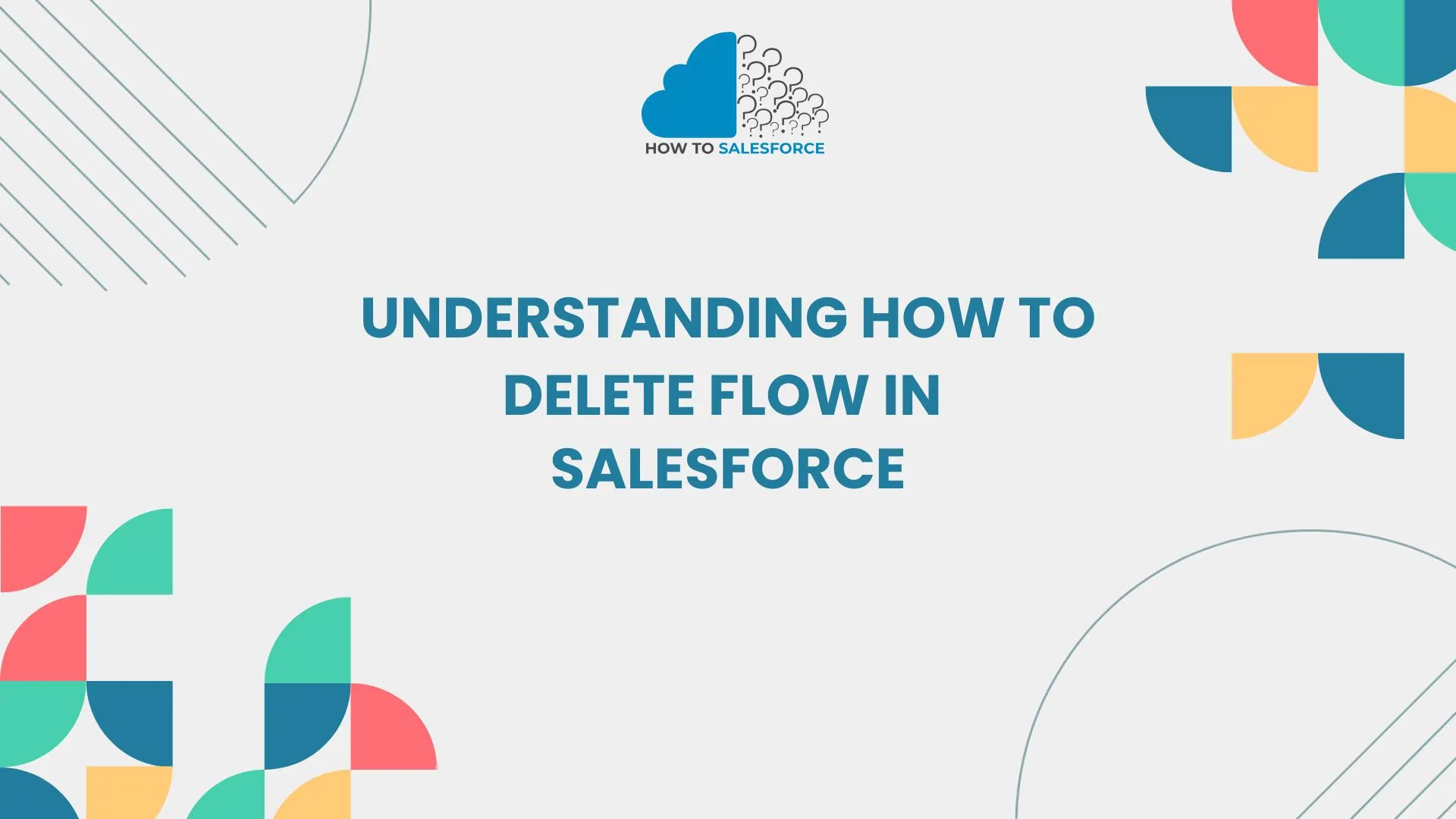Salesforce is a robust platform that enables companies to automate several processes and improve efficiency. Creating and managing flows is one of its primary functions, which lets users automate intricate business procedures with little to no coding knowledge. Maintaining effective and well-organized workflows requires knowledge of How to Delete Flow in Salesforce.
Don’t stop here! Read more about it to expand your knowledge: Salesforce Flow Equals Sum
However, processes change along with businesses, which can result in the accumulation of obsolete or superfluous flow. It’s essential to know how to delete flow in Salesforce in order to keep your automation environment productive and well-organized. This thorough article explains how to remove flows in Salesforce while emphasizing crucial factors and recommended procedures.
Understanding Salesforce Flows
Firstly, understanding what flows are and how they work in Salesforce is crucial before learning how to delete them.
What is a Flow
Moreover, in Salesforce, a flow is a graphic depiction of a business process that enables data collection and task automation. There are several uses for flows, including:
- Data Management: Automate the process of creating, updating, or deleting records.
- User Interaction: Use prompts and screens to lead users through a sequence of actions.
- Email Notifications: Assign the page to the appropriate apps and profiles after creating it.
There are two kinds of Salesforce flows: Auto-launched Flows and Screen Flows. Auto-launched flows operate in the background without user input, whereas screen flows necessitate user interaction.
Importance of Deleting Unused Flows
Furthermore, Effective flow management is essential for several reasons. Maintaining an orderly workspace is facilitated by routinely eliminating unnecessary or out-of-date flows. Let’s examine the advantages of eliminating these flows:
- Efficiency: As your company expands, you might need to develop multiple processes to satisfy different business requirements. It can get harder to find the active flows over time. By removing unnecessary flows, users can navigate more easily and locate what they need more quickly.
- Error Prevention: Conflicts may occur if different flows use the same criteria. For instance, there may be unforeseen repercussions if two flows start on the same record update. Error risk is decreased by eliminating superfluous flows.
- Enhanced Performance: Every flow makes your Salesforce environment more complex. You can improve system performance, shorten load times, and increase platform responsiveness by eliminating unnecessary flows.
- Enhanced User Experience: Users may become confused by a cluttered environment. A cleaner interface makes it simpler for users to navigate and engage with Salesforce by preserving only pertinent flows.
Step-by-Step Process for Deleting a Flow: How to Delete Flow in Salesforce
After learning the significance of eliminating unnecessary flows, let’s examine how to do so in Salesforce.
Step 1: Access Salesforce Setup
- Enter Salesforce login: First, use your login credentials to access your Salesforce account.
- Go to Setup: Click the gear icon in the top right corner of the Salesforce interface after logging in. You will be directed to the Setup menu by doing this.
Step 2: Find the Flow Section
- Find Flows: Find the Quick Find box on the left side of the Setup menu. Enter “Flows” in the search field.
- Select Flows: In the Process Automation section, select the **Flows** option. After performing this action, Salesforce will show you a list of all the flows created in your environment.
Step 3: Identify the Flow to Delete
- Check the List: Look over the list of flows that are visible on the screen. The names, types, and statuses of the flows will be displayed to you. Decide which flow you wish to remove.
- Open the Flow: To see the details of the flow, click on its name. You can view more details about the flow by doing this, which will open the flow detail page.
Step 4: Deactivate the Flow
Salesforce requires a flow to be inactive before you can delete it. To turn off the flow:
- Deactivate: On the flow detail page, look for the Deactivate button. To turn off the flow, click this button. A confirmation message appears stating that the flow has been deactivated.
Step 5: Delete the Flow
Now that the flow is inactive, you can proceed to delete it:
- Delete the Flow: Locate the Delete option on the flow detail page. To begin the deletion process, click on it.
- Confirm Deletion: Salesforce prompts you to authorize the flow’s deletion. Recognize that deletion is irrevocable and irreversible.
- Final Review: Make sure you have chosen the appropriate flow to be deleted by taking a moment to check. The flow will be deleted from your Salesforce environment permanently after you confirm.
Common Scenarios for Deleting Flows
Moreover, process management is more effective when you know when to cut off flows. Deletion may be necessary in the following circumstances:
Replacing Old Automation: How to Delete Flow in Salesforce
Frequently, companies create new procedures that render older ones outdated. If you have developed a more efficient flow that completes the same tasks, you might want to remove the previous one. Restricting yourself to the most effective flows preserves clarity and structure.
Managing Flow Conflicts
Occasionally, you might discover that two flows function according to the same standards, which could result in conflicts. For example, errors or duplication may result if both flows start when a record is updated. In these situations, determine which flow best meets the needs of the business and eliminate the less efficient one.
Handling Unused Flows: How to Delete Flow in Salesforce
Additionally, certain flows may become superfluous as business requirements evolve. Keep an eye on your flow library to find any flows that aren’t being used. Eliminating these flows contributes to a clutter-free and orderly environment.
Alternatives to Deleting Flows
Moreover, alternatives to complete deletion might be more advantageous in some circumstances:
- Deactivating Instead: Prior to deleting a flow, think about deactivating it if you are unsure. This enables you to review the flow at a later time if necessary without affecting ongoing operations.
- Documenting Flows: Record the functionality and goal of a flow if you might need it in the future. In this manner, you can more effectively recreate the flow if necessary.
- Updating Flows: Take into consideration updating a flow to reflect new business processes rather than deleting it. This method increases the efficacy of the original reasoning while maintaining it.
Best Practices for Flow Management
Although, use these best practices for flow management to keep your Salesforce environment tidy and productive:
- Regular Review: Make a plan to go over your flows regularly. This method assists in identifying obsolete or unnecessary flows for removal.
- Documentation: Maintain detailed records of every flow, including its goals, the creators, and the most recent update date. This documentation will help with flow management decision-making.
- User Communication: Alert your group to any changes or deletions to flows. Keeping everyone updated promotes better teamwork and less confusion.
- Testing Before Deletion: Evaluate the effects of removing a flow before doing so. By following this procedure, you can be sure that you won’t interfere with current procedures.
- Version Control: Take into consideration putting in place a version control system if your company regularly updates flows. This system can offer a history of modifications and assist in tracking changes.
Conclusion
In conclusion, effective flow management requires an understanding of how to delete flow in Salesforce. You can improve user experience, streamline navigation, and increase system performance by routinely examining and eliminating unnecessary flows. Your Salesforce environment will continue to be optimized for present and future business requirements if you adhere to the recommended procedures and best practices. Adopt these procedures to keep your automation environment neat and orderly while utilizing Salesforce flows to their maximum potential.


